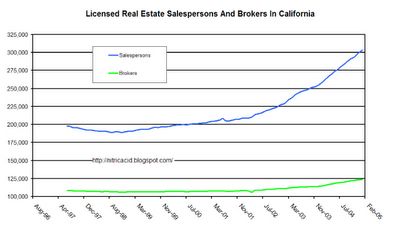Came across these interesting studies done by none other than
Robert J. Shiller of
Irrational Exuberance fame and his partner Karl E. Case:
http://www.cswv.com/research/homeprice/
Some interesting "myth busting". While studying the economics of the late '80s busts in Boston and Los Angeles, they discovered that high unemployment was a
trailing indicator of the recession, and that real-estate prices began falling
before employment figures dropped:
"The fact that prices have since collapsed in both Boston and Los Angeles adds weight to the argument that part of the explanation for the booms lies outside the fundamentals. It is true that the fundamentals deteriorated after 1988 in both cities. This can be seen in Table 5. Employment declines in Massachusetts began in 1989 and became severe in 1990 and 1991. Serious employment decline began in California two years later. But notice that the economic fundamentals deteriorated
after the housing market had turned, not before. Case (1991) presents evidence that the economy of Massachusetts was driven on the way up and on the way down by the real estate cycle itself, not vice versa."
What they mean by "fundamentals" are the normal factors that drive housing appreciation, like income and jobs. One way they define a real-estate bubble is when prices rise above what "fundamentals" would dictate, or when employment figures skew in favor of job types that are directly or indirectly related to servicing the bubble.
For instance, I recently graphed some data I pulled from the
California Department of Real Estate:

As of February 2005, there are currently over 303,000 licensed real-estate sales agents in California. That's a 60% increase since August of 1998!
Competition is fierce out there. The
California Association of Realtors reports a record of over 601,800 existing home sales in 2004. That’s less than two per agent! For the average agent selling the average number of homes at the average price ($450,000) for the
average commission (1.5%), the annual gross was a paltry $13,500 in 2004.
However, multiplying the number of homes sold (602,000), times the median price minus a fudge factor ($400,000), times the total commission paid per transaction (6%), the amount of money paid in commission by Californians last year was over $14 billion dollars! No wonder I see so many
Hummers out there!

No comments:
Post a Comment